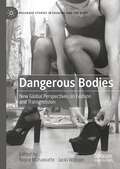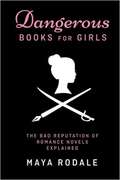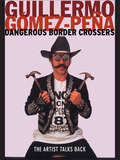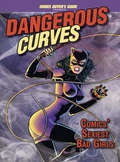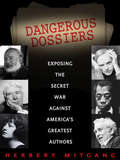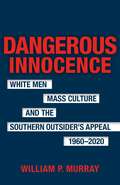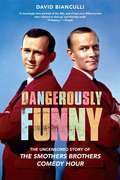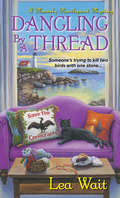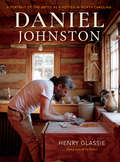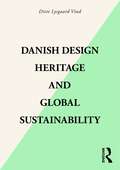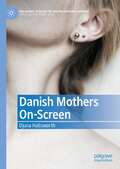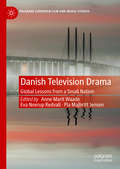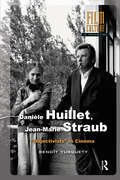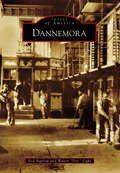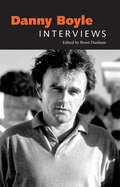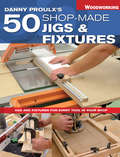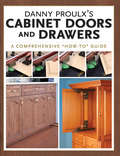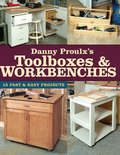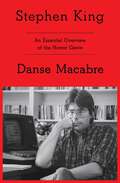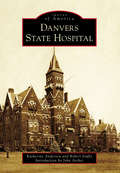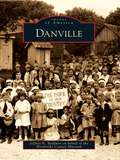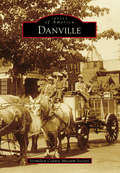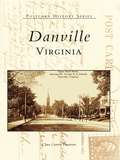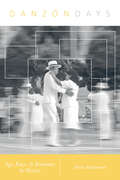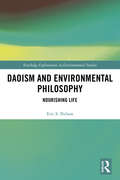- Table View
- List View
Dangerous Bodies: New Global Perspectives on Fashion and Transgression (Palgrave Studies in Fashion and the Body)
by Jacki Willson Royce MahawatteThis edited book brings together new perspectives on fashion, the body, and politics. The intention of this collection is to explore the cultural intersection between bodies, fashion, and transgression, often in the most unlikely of locations. Bodies are political players in culture and the authors gathered here ask a range of pressing questions. What role do fashioned bodies play in resistance, in meeting governmental boundaries or institutional power? Arguably, fashion is an aspect of modern warfare and style can defend and attack in cultural space. So, how do fashioned bodies occupy the grey area between social control and the resistance to power? This book is interdisciplinary and international, with contributors situated within a broad range of disciplines including Art History and Critical Practice, Cultural Studies, Fashion Critical Studies, Film and Literary Studies, Performance Studies, Politics and International Studies, Sociology, Gender, Queer, LGBTI, and Critical Race Studies.
Dangerous Books for Girls
by Maya RodaleLong before clinch covers and bodice rippers, romance novels had a bad reputation as the lowbrow lit of desperate housewives and hopeless spinsters. But why were these books—the escape and entertainment of choice for millions of women—singled out for scorn and shame? Dangerous Books for Girls examines the secret history of the genre’s bad reputation—from the “damned mob of scribbling women” in the nineteenth century to the sexy mass-market paperbacks of the twentieth century—and shows how romance novels have inspired and empowered generations of women to dream big, refuse to settle, and believe they’re worth it. <P><P>For every woman who has ever hidden the cover of a romance—and every woman who has been curious about those “Fabio books”—Dangerous Books For Girls shows why there’s no room for guilt when reading for pleasure.
Dangerous Border Crossers
by Guillermo Gomez-PenaThis anthology of Gómez-Peña's performance chronicles, diary entries, poems, essays, and texts, sheds an extraordinary light on the life and work of this migrant provocateur.
Dangerous Curves: Comics' Sexiest Bad Girls (CBG Presents)
by Brent FrankenhoffThe oh-so-sexy but oh-so-dangerous dames of the comic book world.
Dangerous Dossiers
by Herbert MitgangDangerous Dossiers is as powerful and relevant today as it was when it first made worldwide headlines 25 years ago: a chilling reminder of the dangers of unfettered government intrusion into the lives and beliefs of private citizens, whether famous or not. This shocking account by award-winning author and former New York Times cultural reporter Herbert Mitgang provided hard evidence for the first time of the decades-long cultural war waged by the FBI and other federal intelligence-gathering agencies against scores of the world's most renowned writers and artists. Using the Freedom of Information Act to pry loose actual surveillance files kept by the FBI, Mitgang documented that the targets of government snooping included a who's-who of the literary and artistic worlds whom J. Edgar Hoover and his red-baiting legions suspected of communist leanings or outright disloyalty, usually with no basis whatsoever. They included: Ernest Hemingway, John Steinbeck, William Faulkner, Thornton Wilder, Carl Sandburg, Norman Mailer, Robert Frost, and Allen Ginsburg; and artists including Alexander Calder, Georgia O'Keefe, and Henry Moore. Called "a fascinating, illuminating and above all, morally decent book" by The New York Times, and "first-class journalism" by The Associated Press, this exposé and the many "dangerous dossiers" it contains reveal no evidence of guilt on the part of the targets of the FBI witch-hunts. But Mitgang finds plenty of proof of the paranoia, political bias, and cultural illiteracy of those who controlled the nation's most powerful investigative agencies.
Dangerous Innocence: White Men, Mass Culture, and the Southern Outsider's Appeal, 1960–2020 (Southern Literary Studies)
by William P. MurrayDangerous Innocence investigates how prevailing constructions of white masculinity in the U.S. South help feed and reinforce systems of racial inequity. Tracing the rise of the “southern outsider” in literature and on television from 1960 to 2020, William P. Murray probes white Americans’ enduring desire to assert their own blamelessness even though such acts of self-justification facilitate continued violence against historically oppressed populations. Dangerous Innocence courses from popular television such as The Andy Griffith Show and The Waltons through influential fiction by Eudora Welty, Walker Percy, and other prominent southern authors—alongside forceful challenges voiced by Black writers including Chester Himes and Ernest Gaines—before turning to works created after the September 11 attacks that reinscribe cultural logics predicated on protecting white innocence and power. Concluding on a note of praxis, Dangerous Innocence argues that reattaching southern outsiders to a communal identity encourages an honest assessment about what whiteness represents and what it means to belong to a nation steeped in commitments to white supremacy.
Dangerously Funny
by David BianculliA dramatic behind-the-scenes look at the rise and fall of The Smothers Brothers Comedy Hour--the provocative, politically charged program that shocked the censors, outraged the White House, and forever changed the face of television. Decades before The Daily Show, The Smothers Brothers Comedy Hour proved there was a place on television for no-holds-barred political comedy with a decidedly antiauthoritarian point of view. Censorship battles, mind-blowing musical performances, and unforgettable sketches defined the show and its era. In this compelling history, veteran entertainment journalist David Bianculli draws on decades worth of original research, including extensive interviews with Tom and Dick Smothers and dozens of other key players, to tell the fascinating story of the show's three-year network run--and the cultural impact that's still being felt today.r movement of the late 1960s. Drawing on extensive original interviews with Tom and Dick Smothers and dozens of other key players -- as well as more than a decade's worth of original research -- Dangerously Funny brings readers behind the scenes for all the battles over censorship, mind-blowing musical performances, and unforgettable sketches that defined the show and its era. David Bianculli delves deep into this never-told story, to find out what really happened and to reveal why this show remains so significant to this day.
Dangling by a Thread (A Mainely Needlepoint Mystery #4)
by Lea Wait&“An interesting storyline. If you love cozies you really should try this series!&”—from the USA Today bestselling author of Thread and Gone (Books, Movies, Reviews! Oh My!). The Mainely Needlepointers are about to learn that no man is an island—especially when greedy developers want his land . . . Hermit Jesse Lockhart lives alone on King&’s Island, three miles east of Haven Harbor, Maine, where he&’s created a private sanctuary for the endangered Great Cormorants. But when a wealthy family wants to buy the island and Jesse&’s cousin petitions for power of attorney to force him to sell, Jesse is the one who becomes endangered. Mainely Needlepointer Dave Perry, who befriended Jesse in the VA hospital, rallies the group to his defense. Angie Curtis and the ravelers stitch &“Save the King&’s Island Cormorants&” pillows and sell T-shirts to pay for Jesse&’s legal counsel. But tragically, on a visit to the island, Angie finds Jesse dead. Now the search is on for a common thread that can tie the murdered man to his killer . . . Praise for the Mainely Needlepoint mysteries &“Offers a wonderful sense of place and characters right from the very beginning. Highly recommended.&” —Suspense Magazine &“A cozy debut that hits all the sweet spots: small town, family ties, and a crew of intriguing personalities.&” —Library Journal &“Deep atmosphere, secrets from the past and a mystery interview with sharp plotting and well-developed, sympathetic characters create another winner in the second of the Mainly Needlepoint Mysteries.&” —RT Book Reviews
Daniel Johnston: A Portrait of the Artist as a Potter in North Carolina
by Henry Glassie9780253031884; 9780253022547; 9780253049568
Danish Design Heritage and Global Sustainability
by Ditte Lysgaard VindWith a bias for action, this book offers valuable insights into the origins of the much-celebrated Danish design tradition and how it can be employed to create design solutions to address today’s environmental crisis using the planetary boundaries as positive creative constraints. Danish design has long been revered for its high-quality aesthetics, materials and craftmanship, encouraging sustainability without compromise. This book explores the lessons to be learnt from Scandinavian design ideals, introduces the philosophy and principles of circular economy and showcases the potential power of combining circular economy and design in helping to mitigate the effects of climate change. It presents a range of case study examples across multiple sectors and includes interviews with Danish designers from architecture, furniture, fashion, digital and industrial design, providing unique insights by some of the world’s leading contemporary designers. Bridging theory and real-world insights and experiences, this book builds on the framework of the 4Rs – The Circular Way: Reduce, Reuse, Recycle and Replace to encourage innovation through the replacement of environmentally damaging materials and business models. A must-read for product designers, industrial designers, consultants, business developers, sustainability professionals and students interested in learning how to design and implement circular, sustainable models into practice.
Danish Mothers On-Screen (Palgrave Studies in (Re)Presenting Gender)
by Djuna HallsworthThis book combines content analysis of film and television cases, the examination of policy documents, and first-hand interview material with Danish industry professionals, tracing the pivotal moments in media and welfare state history to unite these two overlapping spheres: welfare state social policy and media imagery. In doing so, it addresses a gap in existing academic and policy documents to demonstrate how motherhood and femininity are presented in contemporary state-supported Danish screen fiction. As an industry premised on state funding and public service values, Danish screen fiction plays a cogent role in shaping and communicating cultural norms and provides a space for the cultivation of belonging and a sense of a shared identity. For this reason, it is vital to identify and examine representational trends and patterns in popular media formats. This book argues that the political narrative of gender equality, democracy and universal social support that permeates Danish state policy is undermined in screen fiction, wherein working mother characters are problematised and the welfare system’s integrity is challenged. This book asserts that the framing of femininity, motherhood and citizenship in many contemporary Danish films and television dramas indicates a cultural concern about the welfare state’s institutionalisation of caregiving and presents absent mothers as an indirect cause of crime, trauma or social unrest.
Danish Television Drama: Global Lessons from a Small Nation (Palgrave European Film and Media Studies)
by Anne Marit Waade Eva Novrup Redvall Pia Majbritt JensenThis book explores how to understand the international appeal of Danish television drama and Nordic Noir in the 2010s. Focusing on production and distribution as well as the series and their reception, the chapters analyse how this small nation production culture was suddenly regarded as an example of best practice in the international television industries, and how the distribution and branding of particular series – such as Forbrydelsen/The Killing, Borgen and Bron/The Bridge – led to dedicated audiences around the world. Discussing issues such as cultural proximity, transnationalism and glocalisation, the chapters investigate the complex interplays between the national and international in the television industries and the global lessons learned from the way in which screen ideas, production frameworks and public service content from Denmark suddenly managed to travel widely. The book builds on extensive empirical material and case studies conducted as part of the transnational research project ‘What Makes Danish Television Drama Travel?’
Danièle Huillet, Jean-Marie Straub: Objectivists in Cinema (Film Culture in Transition)
by Benoît TurquetyDanièle Huillet and Jean-Marie Straub collaborated on films together from the mid-1960s through the mid-2000s, making formally radical adaptations in several languages of major works of European literature by authors including Franz Kafka, Bertolt Brecht, Friedrich Hölderlin, Pierre Corneille, Arnold Schoenberg, Cesare Pavese, and Elio Vittorini. The impact of their work comes in part from a search for radical objectivity, a theme present in certain underground currents of modernist art and theory in the writings of Benjamin and Adorno as well as in the Objectivist movement, a crucial group within American modernist poetry whose members included Louis Zukofsky, George Oppen, and Charles Reznikoff, with connections to William Carlos Williams and Ezra Pound. Through a detailed analysis of the films of Straub and Huillet, the works they adapted, and Objectivist poems and essays, Benoît Turquety locates common practices and explores a singular aesthetic approach where a work of art is conceived as an object, the artist an anonymous artisan, and where the force of politics and formal research attempt to reconcile with one another.
Dannemora
by Walter Pete" Light Rod BigelowThe discovery of iron ore near Chateaugay Lake in 1831 started the settlement later known as the town of Dannemora. In 1832, several local businessmen entered into partnership to mine the ore. St. John B.L. Skinner, a lawyer in Plattsburgh, owned most of the land and named it Dannemora. Dannemora's history is intertwined with iron ore and the development of the prison. The town is located in Clinton County in the foothills of Dannemora Mountain and is within the Blue Line, which marks the border of Adirondack Park. The prison is built on the side of the mountain, and a building to its right, which was the State Hospital for Insane Convicts, is now called the Annex. Surrounding Dannemora are Lyon Mountain, Chazy Lake, and Upper Chateaugay Lake.
Danny Boyle: Interviews (Conversations with Filmmakers Series)
by Brent DunhamA humble man from humble beginnings, Danny Boyle (b. 1956) became a popular cinema darling when Slumdog Millionaire won big at the 2009 Academy Awards. Prior to this achievement, this former theater and television director helped the British film industry pull itself out of a decades-long slump. With Trainspotting, he proved British films could be more than stuffy, period dramas; they could be vivacious and thrilling with dynamic characters and an infectious soundtrack. This collection of interviews traces Boyle's relatively short fifteen-year film career, from his outstanding low-budget debut Shallow Grave, to his Hollywood studio films, his brief return to television, and his decade-in-the-making renaissance. Taken from a variety of sources including academic journals, mainstream newspapers, and independent bloggers, Danny Boyle: Interviews is one of the first books available on this emerging director. As an interviewee, Boyle displays an engaging honesty and openness. He talks about his films 28 Days Later, Millions, and others. His success proves that classical storytelling artists still resonate with audiences.
Danny Proulx's 50 Shop-Made Jigs & Fixtures: Jigs & Fixtures For Every Tool in Your Shop
by Danny ProulxAny savvy woodworker knows that the right jigs and fixtures can greatly expand your capabilities and creativity in the shop. In fact, they'll allow you to perform many tasks that a basic table saw, router, drill press, band saw, or other machine simply can't do alone.In this book, woodworking expert Danny Proulx presents a superb collection of woodworking jigs and fixtures that you can make yourself. They'll help you with everything from sawing panels, tenons, and tapers to routing dadoes, arcs, and circles. You'll discover jigs for making better frame-and-panel doors on the router table, and fixtures that will make gluing up miters and other difficult-to-clamp joints a breeze. Among other things, you'll find plans for a band saw fence that adjusts for blade drift, and a jig for quickly aligning your table saw fence.All of these invaluable shop helpers are easy to build from commonly available materials and supplies. You make these jigs, and they'll make you a better woodworker. Count on it.
Danny Proulx's Cabinet Doors and Drawers
by Danny ProulxBuild Your Own Cabinet Doors and Drawers! With the authoritative advice and easy-to-follow instructions of expert cabinetmaker Danny Proulx, you will be able to make any style of cabinet door and drawer to fit your specific needs and wants. Danny Proulx's Cabinet Doors and Drawers provides the basics of joinery and joint terminology, explanations of door and drawer hardware, tons of helpful shop tips, plus eight chapters devoted to every type of door and drawer imaginable, including: Slab doors Frame and flat panel doors Raised panel doors Cope and stick doors Glass door frames Pocket, flipper and tambour doors Cabinet drawers Inlay door and drawer faces
Danny Proulx's Toolboxes & Workbenches: 13 Fast & Easy Projects
by Danny ProulxBuild toolboxes and workbenches tailored to suit your needs!Why spend countless hours and valuable dollars searching for storage solutions to fit your unique space, needs and wants? Now you can build the perfect toolbox and workbench to meet your specific requirements. Master craftsman Danny Proulx shows you how!Inside Danny Proulx's Toolboxes & Workbenches, you'll find clear, concise instructions and step-by-step photos for creating 13 solid, inexpensive projects. Proulx also provides expert advice and tips on making your workspace safer and cleaner.Make woodworking easier, more efficient and more fun with the toolboxes and workbenches of your dreams!Includes 13 easy projects to fit a variety of spaces and uses:Toolbox toteSimple workbenchFold-away work centerRolling tool cabinetTall storage cabinetsSimple sawhorsesRolling shop cartHand tool wall cabinetBase cabinet work centerCarpenter's toolboxCarver's tool chestMobile tool chestAdjustable worktable
Danse Macabre
by Stephen KingBefore he gave us the &“one of a kind classic&” (The Wall Street Journal) memoir On Writing, Stephen King wrote a nonfiction masterpiece in Danse Macabre, &“one of the best books on American popular culture&” (Philadelphia Inquirer).From the author of dozens of #1 New York Times bestsellers and the creator of many unforgettable movies comes a vivid, intelligent, and nostalgic journey through three decades of horror as experienced through the eyes of the most popular writer in the genre. In 1981, years before he sat down to tackle On Writing, Stephen King decided to address the topic of what makes horror horrifying and what makes terror terrifying. Here, in ten brilliantly written chapters, King delivers one colorful observation after another about the great stories, books, and films that comprise the horror genre—from Frankenstein and Dracula to The Exorcist, The Twilight Zone, and Earth vs. The Flying Saucers. With the insight and good humor his fans appreciated in On Writing, Danse Macabre is an enjoyably entertaining tour through Stephen King&’s beloved world of horror.
Danvers State Hospital (Images of America)
by Robert Duffy John Archer Katherine AndersonPerched high on the top of Hathorne Hill in what was once the village of Salem, Danvers State Insane Asylum was, for more than a century, a monument to modern psychiatry and the myriad advances in mental health treatment. From the time it opened its doors in 1878 until they were shuttered for good in 1992, the asylum represented decades of reform, the physical embodiment of the heroic visions of Dorothea Dix and Thomas Story Kirkbride. It would stand abandoned until 2005, when demolition began. Along with a dedicated group of private citizens, the Danvers Historical Society fought to preserve the Kirkbride structure, an effort that would result in the reuse of the administration building and two additional wings. Danvers has earned a unique place in history; the shell of the original Kirkbride building still stands overlooking the town. Though it has been changed drastically, the asylum's story continues as do efforts to memorialize it.
Danville
by Hendricks County Historical Museum Jeffrey K. BaldwinDanville, created in 1824 as the county seat of Hendricks County, was the hub of government, commerce, and agriculture. Farmers sold their crops in town and shopped there. As the agricultural economy diminished, Danville became home to workers commuting to Indianapolis. Danville residents have always valued education. On May 10, 1878, at the instigation of Prof. W. F. Harper of the Central Normal School of Ladoga, 50 farm wagons from Danville arrived at Ladoga and stole the whole school, including equipment, students, faculty, and baggage. Central Normal College was then installed in the facility previously housing the Hendricks County Seminary and the Danville Academy. From 1878 to 1951, Central Normal College was a Danville institution, turning out more than 75,000 graduates destined for leadership roles in education, business, law, and politics.
Danville (Images of America)
by Vermilion County Museum SocietyNamed after early pioneer and fur trapper Dan Beckwith, Danville was a dream realized when the first town lots were auctioned on April 10, 1827. The town grew, especially after the "iron horse" made its way into the area. The railroad opened the doors to Danville's rich manufacturing potential, and the town expanded. Serving as the Vermilion County seat, Danville has undergone many changes in the last 70 years. Although the focus of its economy has changed, the days of General Motors, Chuckles, General Electric, and many more businesses and industries that provided work and brought people to the county linger in memory. Employment provided a rich and full life upon which the heritage of Danville was built.
Danville, Virginia (Postcard History)
by Clara Garrett FountainSince its incorporation in 1833, Danville has proved one of the Old Dominion State's most interesting and historic cities, ranging from its brief stint as the last capital during the waning hours of the Confederacy, to its role as a major tobacco and textile producer in the late nineteenth and early twentieth centuries, to the city's infamous disasters, such as the wreck of the Old 97. In these images, readers will journey back into the Danville of yesteryear and explore many elements of the city's past: its historic churches along Main Street, its stunning Victorian and Edwardian architectural treasures along Millionaires Row, and many of the city's most recognizable structures, including schools, businesses, and early government buildings.
Danzón Days: Age, Race, and Romance in Mexico (Music in American Life)
by Hettie MalcomsonOlder people negotiating dance routines, intimacy, and racialized differences provide a focal point for an ethnography of danzón in Veracruz, the Mexican city closely associated with the music-dance genre. Hettie Malcomson draws upon on-site research with semi-professional musicians and amateur dancers to reveal how danzón connects, and does not connect, to blackness, joyousness, nostalgia, ageing, and romance. Challenging pervasive utopian views of danzón, Malcomson uses the idea of ambivalence to explore the frictions and opportunities created by seemingly contrary sentiments, ideas, sensations, and impulses. Interspersed with experimental ethnographic vignettes, her account takes readers into black and mestizo elements of local identity in Veracruz, nostalgic and newer styles of music and dance, and the friendships, romances, and rivalries at the heart of regular danzón performance and its complex social world. Fine-grained and evocative, Danzón Days journeys to one of the genre’s essential cities to provide new perspectives on aging and romance and new explorations of nostalgia and ambivalence.
Daoism and Environmental Philosophy: Nourishing Life (Routledge Explorations in Environmental Studies)
by Eric S. NelsonDaoism and Environmental Philosophy explores ethics and the philosophy of nature in the Daodejing, the Zhuangzi, and related texts to elucidate their potential significance in our contemporary environmental crisis. This book traces early Daoist depictions of practices of embodied emptying and forgetting and communicative strategies of undoing the fixations of words, things, and the embodied self. These are aspects of an ethics of embracing plainness and simplicity, nourishing the asymmetrically differentiated yet shared elemental body of life of the myriad things, and being responsively attuned in encountering and responding to things. These critical and transformative dimensions of early Daoism provide exemplary models and insights for cultivating a more expansive ecological ethos, environmental culture of nature, and progressive political ecology. This work will be of interest to students and scholars interested in philosophy, environmental ethics and philosophy, religious studies, and intellectual history.
